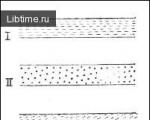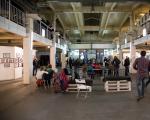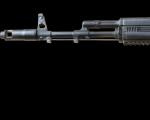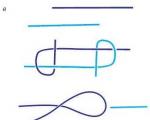Motor show in Patriot Park. Holiday weekend in Patriot Park
6+
On May 19-20, the third multi-format festival “MotoArmy” will be held in Patriot Park!
How it will be and what awaits you:
A coordinated column of 2000-3000 motorcyclists gathers on Poklonnaya Hill.
Entry is free for all convoy participants.
A military band will greet the column in Patriot Park on the territory of the Convention and Exhibition Center.
The following will perform on stage:
Mommies Bend
Easy Dizzy (official AC/DC tribute in Russia)
VESPERSELLOS (rock on cellos)
Headliner - PILOT band
Host - Igor Pankov (“Our Radio”)
Open area:
- performance by stunt riders;
- demonstration races of the CASCADE group;
- motorcycle gymkhana competitions;
- motocross competitions;
- karting test drives;
- test drives of KTM motorcycles;
- test drives of electric motorcycles and gyrotechnics;
- Museum of retro traffic police equipment;
- program from the Federation of all-around powerlifting with weight lifting, cars, etc.;
- passing GTO standards, as well as tug of war and arm wrestling from DOSAAF Russia;
- test drive of car sharing in the park;
- a large children's program with the participation of "Biker Baby" and "Mototherapy", cyber games, interactive activities and competitions;
- drag racing competitions.
In the pavilion:
- auto, motorcycle and air exhibition;
- custom show;
- business representatives (dealers, showrooms, representative offices);
- extreme technology;
- fair;
- exhibition of sports cars (Formula 1 car, Ferrari F430, Porsche Carrera 911 4S, BMW M3 tuning, Shortcut).
In the air:
- more than 20 takeoffs of small and sport aircraft with the implementation of the program;
- a helicopter from DOSAAF, which will show those interested the surroundings and the Patriot Park from a bird's eye view.
The first All-Russian Festival of Soviet Toys will be held as part of the MotoArmiya festival: children's pedal cars, models of equipment, electromechanics, even Soviet game consoles and much that you remember from childhood.
Dear friends! Visitors and guests of the Patriot Park.
We invite you from April 29 to May 9 spend weekends and holidays in Patriot Park.
Historical events, themed events, interactive platforms and master classes await you.
FOR THE FIRST TIME, in the Patriot Park during the holidays, visitors will be able to see exhibits of armored vehicles and armored vehicles, as well as, only on May 9, the world's largest Soviet heavy multi-purpose transport helicopter MI-26.
The opening of the exhibits is a unique opportunity to look inside military equipment
During the holidays, visitors will have the opportunity to look inside the exhibits of armored vehicles and armored vehicles, as well as, only on May 9, the world's largest multi-purpose transport helicopter, the MI-26.
- Historical armored vehicles: BT-2, T-34-85, SU-100, BM-13 "Katyusha".
- Soviet trucks: Gas-64, Zil 157, Zil 130.
- Aircraft: MI-26 (only May 9) - the world's largest Soviet heavy multi-purpose transport helicopter!
- Aircraft: MI-8, Airplane.
- Medium and main battle tanks (MBT): T-72, T-80.
Dates: April 29 - May 9.
Time: 10:00 - 18:00
Location: Museum site No. 1.
Ticket price:
Episode-reconstruction “Life and life of a partisan detachment”
- In the dugouts and dugouts of the Partisan Village, guests and visitors will be greeted by reenactors in costumes and images of partisans from the Great Patriotic War. Thematic history lessons will immerse those attending in the daily life of partisans during the turbulent war years.
- Guests will witness a meeting with the commander of a partisan detachment, and will also learn the peculiarities of the tactics of partisans in the forest and methods of carrying out sabotage combat against the enemy.
Time: 10:00 - 19:00.
Location: VEC "Partisan Village".
Ticket price: is included in the price of the entrance ticket to the VEC “Partisan Village” (tickets can be purchased at the Park ticket office and on the official website in the section).
Shooting tournament dedicated to the 73rd anniversary of the Victory
WITH April 29 to May 9 2018 will be held on the territory of the world's largest. As part of the tournament, every visitor (over 18 years old) will be able to test his accuracy when shooting from a carbine Saiga MK(civilian version of the legendary Kalashnikov assault rifle).

How to take part in the tournament
Visitors must purchase a certificate for participation in the tournament at one of the ticket offices of the Patriot Park, directly at the Multifunctional Fire Center. The certificate includes: 10 shots per test (you can improve your result an unlimited number of times by purchasing additional certificates).
Patriotic event “Candle of Glory” dedicated to the celebration of Great Victory Day
- In the partisan village, all guests of Patriot Park are expected around the fire to sing everyone’s favorite front-line songs and light memorial candles.
Time: 18:00.
Location: VEC "Partisan Village".

Interactive exhibition "Medsanbat"
- During the war years, a sanitary and medical service was organized in the USSR, which was considered one of the most effective in the world. Plunging into the atmosphere of a wartime field hospital will be interesting for both adults and children.
- The exhibition will feature materials from the Great Patriotic War, as well as a reception and sorting department, a dressing room and an evacuation department. Guests will be shown dressing materials, medical instruments from the war, and will be told how the reception, provision of medical care and further evacuation of the wounded during the Great Patriotic War was carried out.
Time: 10:00 - 17:00.
Location:
Price: is included in the price of the entrance ticket to the VEC “Partisan Village” (tickets can be purchased at the Park ticket office and on the official website in the section).
Taking photographs in military uniform and with models of historical weapons
Everyone will be able to try on the uniform of a soldier of the Workers 'and Peasants' Red Army, as well as the latest "Ratnik" equipment.
- At the same time, models of historical weapons of the Great Patriotic War will be presented to guests.
- Everyone will be able to take a photo in any type of uniform and visually examine the uniform items of the servicemen of the Workers' and Peasants' Red Army.
Time: 10:00 - 18:00.
Location: Museum site No. 1.
Price: is included in the price of the entrance ticket to the VEC “Partisan Village” (tickets can be purchased at the Park ticket office and on the official website in the section).
Military face painting for the youngest guests
- Young guests and visitors to Patriot Park will be offered the opportunity to make real war paint. The lesson will be exciting and interesting, because you can choose any drawing giving free rein to your imagination.
Time: 11:00 - 18:00.
Location:
Ticket price: is included in the price of the entrance ticket to the VEC “Partisan Village” (tickets can be purchased at the Park ticket office and on the official website in the section).

- Military specialists of the Aerospace Forces will conduct excursions in the Space Forces pavilion for guests of Site No. 1 of the Museum complex.
Time: 11:00 - 18:00.
Location: site No. 1 of the Museum complex.
Ticket price: is included in the price of the entrance ticket to the VEC “Partisan Village” (tickets can be purchased at the Park ticket office and on the official website in the section).
Shooting from historical quenched weapons
- At the open exhibition of Site No. 1 of the Museum complex, everyone will be able to shoot from historical weaponry from the times of the Great Patriotic War.
Time: 10:00 - 19:00. Location: open exhibition of Museum site No. 1.
Price:prices can be found
- In collaboration with the Federation of Tank Model Sports, an impromptu track has been organized for guests, where everyone can try themselves in driving a model tank.
Time: 11:00 - 18:00.
Location: site No. 1 of the Museum complex.
Ticket price: 350 rubles, 10 minutes.
*The program of events is subject to change. Stay tuned.
"In 1950, the Air Force Commander-in-Chief, Marshal K.A. Vershinin, approached S.A. Lavochkin with a proposal to build a radio-controlled target for training pilots, and on June 10, a government decree was issued on the development of product “201,” the future La-17. Special attention during the creation product "201" was given to reducing its cost, because the "life" of the machine was supposed to be short-lived - just one flight. This determined the choice of the RD-800 ramjet (diameter 800 mm), which ran on gasoline. They even abandoned the fuel pump, making the fuel supply a displacement using an air pressure accumulator. The tail and wing (based on economics) were made straight, and the latter was assembled from SR-11-12 profiles. The most expensive purchased items, apparently, were radio control equipment, which was powered by a wind-electric motor installed in the forward part of the fuselage , and autopilot.
...
Looking ahead, we note that it was not possible to achieve reliable operation of the parachute-jet rescue system. But the idea of reusing the target did not die out, and they decided to land it from gliding on an engine protruding under the fuselage. To do this, before landing, the target was transferred to high angles of attack, reduced speed and parachuted. Flight tests confirmed this possibility, only in this case the engine nacelle was deformed and the ramjet engine needed to be replaced. During factory tests, difficulties arose with starting the ramjet at low air temperatures, and it had to be modified.
...
Immediately after separation from the carrier, the target was transferred to a shallow dive to increase speed to 800–850 km/h. Let me remind you that the thrust of a ramjet engine is related to the speed of the oncoming flow. The higher it is, the greater the thrust. At an altitude of about 7000 m, the target was taken out of the dive and, following radio commands from the ground control point, was sent to the training ground.
...
Serial production of the “201” product, which received the designation La-17 after being put into service, began at plant No. 47 in Orenburg, and the first production vehicles left the assembly shop in 1956. Six Tu-4 bombers were modified for La-17 launches in Kazan.
The target, apparently, turned out to be successful, but it had one significant drawback - the need for a Tu-4 carrier aircraft, the operation of which cost a pretty penny, and the straight-through one consumed quite a lot of gasoline. Appetite, as you know, comes with eating. The military wanted to expand the range of tasks solved by the target. So they gradually came to the idea of replacing the ramjet engine with a turbojet engine."
Source: Nikolai Yakubovich, “Unknown Lavochkin”



“At the end of 1958, to train combat crews of the air defense missile system, at the suggestion of A.G. Chelnokov, they worked on a version of the “203” machine with a short-life turbojet engine RD-9BK (modification of the RD-9B, removed from MiG-19 fighters) with a thrust of 2600 kgf and a pair of solid propellant boosters PRD -98 and ground launch. A maximum speed of 900 km/h, an altitude of 17–18 km and a flight duration of 60 minutes were specified. The new target was located on a four-wheeled carriage of a 100-mm anti-aircraft gun KS-19. The turbojet engine expanded the flight altitude range to 16 km. Flight testing of the modernized target began in 1956, and two years later the first products began to leave the workshops of the plant in Orenburg.In May 1960, joint state tests began, in the same year the target under the designation La-17M was accepted into service, and it was produced until 1964 of the year.
It is known that when objects moving towards each other approach, their relative speed adds up and can become supersonic. Moreover, by changing the angles at which objects meet and their angles, you can increase or decrease the relative speed. This technique was used as the basis for training combat crews when firing at the La-17M, thereby expanding the capabilities of the target. And the long duration of its flight made it possible to simulate targets from a cruise missile to a heavy bomber. For example, the installation of corner reflectors (Luniberg lenses) made it possible to change the effective dispersion surface (ESR) and “create” targets on radar screens that imitate front-line and strategic bombers.
In 1962, in accordance with the November 1961 government decree, the La-17 was once again modernized. The industry was given the following tasks: to expand the altitude range of the target from 3-16 km to 0.5-18 km, to change the reflectivity of the target in the 3-cm wavelength range to simulate, in particular, the FKR-1 cruise missile, as well as Il aircraft -28 and Tu-16. For this purpose, a high-altitude RD-9BKR engine was installed, and a Luniberg lens with a diameter of 300 mm was installed in the rear fuselage. The target tracking range of the P-30 ground radar has increased from 150–180 km to 400–450 km. The range of simulated aircraft has expanded.
To reduce the losses of undestroyed vehicles during landing, its landing gear was modified. Now, at the minimum calculated altitude, a load was thrown out of the rear fuselage, connected by a cable to a pin, when pulled out, the autopilot transferred the target to a high angle of attack. Parachuting, the target landed on skis with shock absorbers placed under the turbojet engine nacelle. State testing of the target took three months and ended in December 1963. The following year, the target under the designation La-17MM (product “202”) was put into mass production.
But the story of the La-17 radio-controlled targets did not end there. Stocks of RD-9 engines quickly depleted, and in the 1970s there was a proposal to replace them with R11K-300, converted from R11F3S-300, installed on MiG-21, Su-15 and Yak-28 aircraft. By this time, the enterprise bearing the name S.A. Lavochkin, completely switched to space themes, and it was planned to transfer the order to the Orenburg production association "Strela". But due to the low qualifications of the employees of the serial design bureau, in 1975 the development of the latest modification was entrusted to the Kazan Design Bureau of Sports Aviation "Sokol". The modernization, which outwardly seemed simple, dragged on until 1978, and the target under the designation La-17K was mass-produced until mid-1993.
By the mid-1970s, there were still quite a few La-17Ms at the test sites, although they were considered obsolete, they were used for their intended purpose. The reliability of the telecontrol system left much to be desired, and radio equipment often failed. In 1974, I witnessed when a target launched at a training ground in Akhtubinsk, standing in a circle, refused to obey the ground operator and, blown away by the wind, moved towards the city. One could only guess about the consequences of its soaring flight after running out of fuel, and a MiG-21MF with an experimental “Wolf” optical sight was raised to intercept the “rebellious” target. Four “blanks,” as armor-piercing shells are commonly called, fired from a distance of 800 m, were enough for the La-17M to turn into a heap of shapeless debris."




